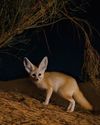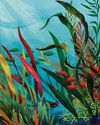LET'S GET TOGETHER
BBC Wildlife
|January 2025
Clay licks deep in the Amazon explode in a riot of colour, with macaws the stars of the show

IT MAY BE THE WORLD'S LARGEST AND largest and most biodiverse ecosystem, but it can be surprisingly difficult to see much in the Amazon. The majority of species are placed firmly in the ‘shy and secretive’ category, and even spotting birds is tricky, given the dense nature of the forest foliage. However, if you like your fauna to put on a show, worry not. Select sites along the western reaches of the Amazon basin host a dazzling phenomenon that is the ornithological equivalent of shooting fish in a barrel.
Did you know?
Macaws feed large amounts of clay, through regurgitation, to their chicks. The youngsters need the sodium in the clay for the development of bone, muscle and nervous and circulatory systems.
Described by researcher Elizabeth Hobson as "a crazy, screaming kaleidoscope of colour," the spectacle of scarlet macaws and other parrot species breaking cover and descending en masse to feed along eroded, clay-rich cliffs and riverbanks (known as 'clay licks' or collpas), presents the opportunity to boost your bird list while revelling in some fascinating behaviour.
Dit verhaal komt uit de January 2025-editie van BBC Wildlife.
Abonneer u op Magzter GOLD voor toegang tot duizenden zorgvuldig samengestelde premiumverhalen en meer dan 9000 tijdschriften en kranten.
Bent u al abonnee? Aanmelden
MEER VERHALEN VAN BBC Wildlife

BBC Wildlife
"I was terrified the elephant would ram us"
African elephant in Kenya
2 mins
January 2026

BBC Wildlife
ALL YOU EVER NEEDED TO KNOW ABOUT THE Fennec fox
THE FENNEC FOX IS THE SMALLEST fox in the world, with a body length that can be as little as 24cm.
3 mins
January 2026

BBC Wildlife
INTO THE PLASTISPHERE
A unique synthetic ecosystem is evolving in our oceans – welcome to the plastisphere
7 mins
January 2026

BBC Wildlife
“More than half of all animal life exists in a parasitic relationship, and all life lives in symbiosis”
Our survival depends on species evolving to live together - but some relationships take dark turns
7 mins
January 2026

BBC Wildlife
Are animals able to dream?
SLEEP IS A MYSTERIOUS THING. FOR A long time, we weren't sure why we do it.
1 mins
January 2026

BBC Wildlife
Does a cuckoo know it's a cuckoo?
ABSURD LITTLE BIRDS ACROSS THE world lay their eggs in the nests of other species, leaving the hapless parents to raise a changeling at the expense of their own offspring.
2 mins
January 2026

BBC Wildlife
Orcas killing young sharks
Juvenile great whites are easy prey for orca pod
1 mins
January 2026

BBC Wildlife
Ocean goes on tour
Acclaimed film touring the UK, backed by live orchestra and choir
1 min
January 2026

BBC Wildlife
Feisty bats hunt like lions
Winged mammals use a 'hang and wait' strategy to take down large prey
1 mins
January 2026

BBC Wildlife
SNAP-CHAT
Richard Birchett on magical merlins, wily coyotes and charging deer
2 mins
January 2026
Listen
Translate
Change font size

